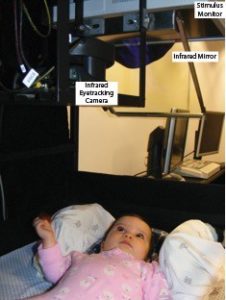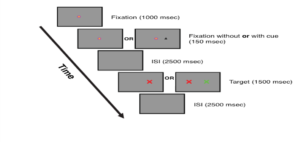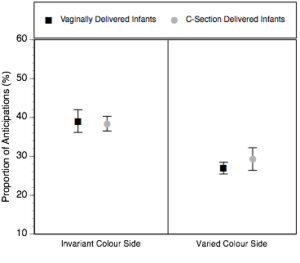What does Beyoncé have in common with Pamela Anderson, but not with Britney Spears and Angelina Jolie? And what is it that Britney and Angelina have in common? Apparently, Britney and Angelina gave birth to their babies by caesarian section whereas Beyoncé and Pamela gave birth naturally. This is the only thing I know about those celebrities (I don’t even know what they are famous for, although I suspect it’s not their citation index), and I had to look it up.
Why would I bother?
According to recent research published in the Psychonomic Society’s journal Attention, Perception, & Psychophysics, knowing how someone has come into this world may tell us something about their early cognitive behavior.
Researchers Scott Adler and Audrey Wong-Kee-You of York University in Canada examined how the method of delivery affects the early development of an infant. It has long been known that early-birth factors such as birth weight and a mother’s age affect the infant’s development, but until now, nothing has been known about the differences, if any, between natural birth and delivery by caesarian section in subsequent cognitive development.
Adler and Wong-Kee-You conducted two studies that explored one cognitive mechanism that even three-month-old babies are already learning to perform; namely visual attention and related eye movements. It is known that attentional allocation and linked eye movements are controlled by the somatosensory cortex in humans, and there is suggestive evidence in other species that development of that part of the brain is affected by the level of the neurotransmitter serotonin in the brain, which in turn may vary with the way of delivery.
In both studies, the participants (3-month-old infants) were lying in a specially designed crib with a monitor suspended above them that displayed the stimuli. A special infrared mirror permitted the experimenters to keep track of where the infant was looking without interfering with the baby’s ability to watch the monitor. The figure below shows the arrangement:

The stimuli and the experimental task for the first study are shown in the next figure. The basic idea was to cue the infant with the little black triangle (second pair of frames from the top) on some trials, and to examine whether that was enough to attract their attention—as revealed by eye movements observed through the one-way mirror—to the target a few seconds later. As shown below, the target was a red or green cross, which was presented either on its own or together with a second, distracting cross of the other color. (This manipulation turns out not to make a difference to the conclusions and can therefore be ignored.)

This procedure permits measurement of spatial attention by comparing the speed of eye movements between cued and uncued trials. If an infant responds to the cue, then they should move their attention towards the target—which is presented on the same side as the cue—before it appears, and their subsequent eye movements towards the target should be quicker.
This is exactly what happened: infants were 1/10th of a second quicker to move their eyes to the target once it appeared if they had previously seen the cue than if they had not. This finding confirms two important facts: First, the infants had developed some attentional ability at the age of 3 months. Second, the experimental procedure was able to pick up this attentional ability, and should therefore be able to shed light on the question of interest; namely, whether the method of delivery had an effect on those attentional abilities.
The results showed that, indeed, there was a difference in eye movement speed between the two different delivery methods: babies who were born vaginally moved their eyes on average 1/10th of a second more quickly than babies who were delivered by caesarian. Natural birth seems to bestow a small attentional advantage very early in life.
Adler and Wong-Kee-You next asked whether the type of delivery might also affect other forms of attention, based on expectation rather than specific cues. Recall that in the first study, each trial involved a cue that signaled the location of the target: Babies therefore merely responded to a cue but there is no way to see if the babies learned to form some expectation about the stimuli.
To examine the possibility that babies might learn to expect stimulus features, Adler and Wong-Kee-You performed a second study in which the stimulus sequence was predictable. Specifically, in the second study the stimuli consisted of colored shapes that were presented either on the left or the right of the screen, in an alternating sequence. Infants were therefore able to anticipate the location of the next stimulus at any time. The stimulus sequence had one other crucial attribute: the color combination of stimuli appearing on one side (let’s say the left) was invariant whereas the colors of stimuli on the other side (the right) varied. For example, all stimuli on the left might be red and blue, whereas those on the right would variously be red and green, then blue and yellow, then red and yellow, and so on.
Based on previous research, Adler and Wong-Kee-You expected babies to anticipate the stimuli on the side that involved an invariant color pairing more than stimuli on the varied side—that is, babies were expected to move their eyes to the invariant-color side before the stimulus appeared more often than they would move to the other side. The figure below shows that this is exactly what was observed: Note that there were more anticipations in the left panel (invariant color) than in the right panel (varied color).

Babies anticipated the stimulus that they knew would be presented in a familiar color pairing, suggesting that they developed an expectation of what they would see on one side of the screen.
The figure shows another interesting result: Unlike in the first study, there was no difference in the ability to anticipate a stimulus between vaginally-delivered babies and infants delivered by caesarian.
Does this mean the first result might have been a one-time event; some sort of statistical fluke? No, because the same effect was also present in the second study when eye movements were analyzed with respect to stimulus onset (I am not showing those data here to keep things simple).
The effect of birth experience was thus observed in both studies, but only in response to stimulus-driven cueing of attention. By contrast, there was no effect of birth experience on attentional behavior that was driven by learned, cognitive expectations. This rather subtle pattern isolates the specific attentional ability that may be affected by birth experience; namely, the efficient responding to a visual cue.
Adler and Wong-Kee-You underscore the importance of their findings by highlighting the fact that the number of caesarean sections being performed has been steadily increasing. Several professional bodies, such as the American College of Obstetricians and Gynecologists, and the Society for Maternal-Fetal Medicine, have expressed concern about this trend for a number of health-related reasons. The work of Adler and Wong-Kee-You adds a cognitive dimension to this concern.
Should these results necessarily alarm expecting mothers who are considering delivery by caesarian? Probably not. The size of the effects observed by Adler and Wong-Kee-You is not unlike that observed as a consequence of the mother receiving an epidural during a vaginal birth. Moreover, many other factors also affect cognitive development, such as breast feeding, or brain structure, such as raising a child bilingually, that are not always under the parents’ control.
It is valuable to know about those factors, but it does not follow that one has to forsake an epidural, avoid a caesarian, and seek a husband whose native language is not English in the interest of one’s baby. The most important factor for a person’s long-term well-being is emotional health in childhood, and there is no evidence to suggest that this is affected by birth experience.

3 Comments